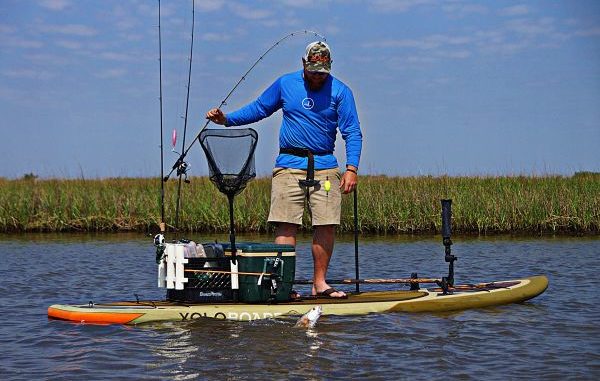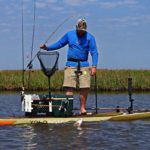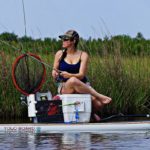
Stand up paddle boards are new fishing frontier
A poster on a fishing forum wrote that he was quitting kayak fishing because it was “becoming too mainstream.” He was kidding of course, but he made his point.
Kayak fishing has become so popular that there are very few fishing locations where you won’t see one.
What’s turning heads now are anglers on stand-up paddle boards (SUPs).
Popular in many coastal destinations, SUPs began as an offshoot of surfing. The pioneers used long paddles to propel their boards farther distances to hitch a ride on a wave. The evolution of the boards changed the common meaning of SUP from “stand-up paddling” to the boards that are now used for doing so.
So what does that have to do with fishing?
Like virtually any craft, if it accesses the water, someone has designed or modified it to use as a fishing platform. SUPs are no different.
Paddle boards evolved from surfing to exercising to sightseeing. Now, fishing has become a growing segment of the many uses for the boards.
The same as canoe and kayak manufacturers have done, SUP companies now make models and accessories specifically designed for fishing. Several accessory companies have also jumped on “board,” recognizing the growth of the sport.
Why fish from a SUP? The two biggest reasons are visibility and stability.
Sitting so low to the water to fish, as with a kayak, limits visibility — of being seen and especially for seeing into the water at any distance. Stand-up fishing can be done from kayaks, but the boards are more stable than many ’yaks.
Kayaks are also too confining for some people, and they find being restricted to the seat area only unappealing. Stand-up boards offer the stability to move around while easily going between standing, kneeling or sitting positions.
“I wasn’t really comfortable in a kayak and always felt off-balance. About four years ago, I got on my first paddle board, and I was obsessed,” Kalley LeRoy said.
She should know: LeRoy is the 2014 reigning champion of the world’s largest kayak fishing tournament — Ride the Bull. She bested 731 other competitors to take home first place at the prestigious tournament.
And, yes, she was on her YOLO paddle board.
Kalley and husband Jared went all-in for SUP fishing. Jared started making suggestions to their favorite board company, and both are now YOLO Fishing Team ambassadors.
Weight is another factor often cited by those choosing SUPs over other types of paddle craft.
“My board is stable and super light. I can carry it by myself,” she said.
Many boards have built-in handles for ease of carrying. SUPs can be launched nearly anywhere you can walk to.
Resembling surf boards on steroids, most SUPs are wide and have some type of non-slip padding over a majority of the deck.
Another added attraction is that the deck is a blank slate users can customize as they wish. If only going out for a leisurely exercise or sightseeing trip, one only needs to grab their paddle and a PFD.
However, for those looking to customize their boards for fishing, a wide array of options and accessories are available. The most-popular accessory is a small ice chest. Doubling as a seat and a place to keep your catch and refreshments, many ice chests work well on an SUP.
The boards have built-in grommets for lashing down gear, and some have fisher friendly mounts for rod holders, GoPros and other accessories.
Plastic crates are another popular accessory to keep your tackle and gear contained and onboard. SUP’s have no sides, so any gear not attached can easily go for a swim.
Most SUPs are constructed of slick gel coats over fiberglass outer surfaces and lightweight foam core. The boards are durable, buoyant and easily transportable. Removable keel fins allow several boards to be stacked for transport on a roof top of a car or in the bed of a pickup truck.
Technological advances have made for the advent of inflatable boards that offer the convenience of compact storage, but when inflated, the boards boast a rigid surface that rivals that of the solid-core models. The deflated boards are easy to store and transport.
SUPs draft only inches, and are great for plying skinny water flats. However, they are not only confined to backwaters.
Outfitted with specialty leaning posts/rod holder combinations, adventurous anglers are taking their boards into bigger waters. Impressive catches of reef fish, tarpon and even billfish have been made by anglers fishing on SUPs.
Cementing the fact that SUPs are growing in popularity, several years ago the U.S. Coast Guard classified them as vessels the same as canoes and kayaks.
The rules regarding PFDs apply to SUP “riders.” In Louisiana, that means that the rider must have in their possession an appropriate, wearable PFD. Of course, the best practice is to wear the PFD at all times.
SUPs use specialty paddles that have single blades and long handles. The art of paddling a board is a learned technique, but is quite easy and efficient once you get the hang of it. Most boards track well, and paddling provides a great core workout.
With no internal storage like a kayak, gear choices should be well thought out and limited to only what you really need.
The first consideration is keeping gear dry that needs to stay dry. A quality dry bag or case is a necessity. Most wallets, keys, phones and cameras don’t take kindly to going for a swim.
Add rod holders to your ice chest or crate so you can take along a spare or two. Use leashes to keep nets, lip grips and hook-outs tethered to the board but accessible without unleashing them.
Pick your favorite lures and pack them in a small, waterproof tackle tray.
So if you’re looking for an exciting way to combine exercise and adventure, consider SUP fishing. You’ll be up close and personal with your quarry and silently in tune with the nature that surrounds you.
You only live once.




